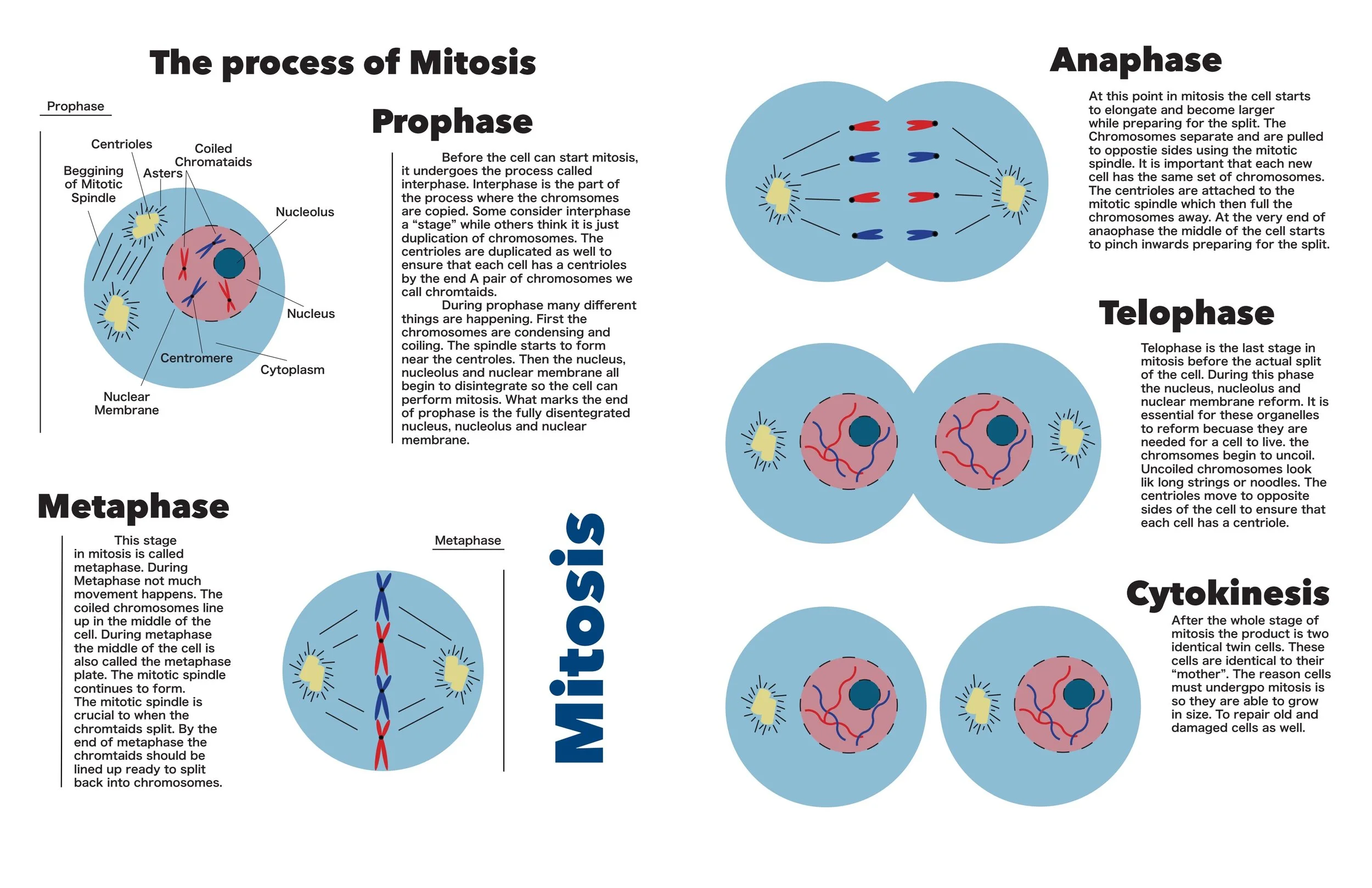Mitosis
Mitosis is the process cells undergo to divide. The reason mitosis is crucial to all organisms is because it is what causes growth and repair within cells. For example, someone gets a paper cut and over time it begins to heal and the skin comes back. That is mitosis on a small scale. The result of mitosis is two identical cells, also referred to as “daughter cells” (Britannica, T. Editors of Encyclopaedia, 2024). It is a simple crucial process of growth that all cells must go through.
A cell spends most of its life in interphase which includes growth phases that are not mitosis. There is the G1 phase which is growth in the cell, the S stage which is DNA replication and then the G2 stage DNA coils and organelles and “equipment” needed for mitosis are prepared (Sandra Alters & Brian Alters, 2006).
After interphase, prophase begins. Prophase is the phase where all DNA is coiled and condensed into chromosomes. The DNA is condensed and packed up into chromosomes so that none of it will get lost during the process of division. It can be thought of as packing up boxes when someone is moving so that nothing will get lost in the process. During prophase, the nucleus, nucleolus, and nuclear membrane all dissolve. This happens so that the cell will be able to begin metaphase, the next stage of mitosis (Britannica, T. Editors of Encyclopaedia 2023).
Metaphase is crucial to cell division because this phase begins the lining up of the chromosomes. In the middle of the cell, chromosomes line up to then be pulled apart during anaphase. The mitotic spindle is what is used to pull apart the chromatids (Petruzzello, 2023). The chromatids are created during the DNA replication. Chromatids consist of a short arm, a long arm, and a centromere that connects the two (Rogers, 2023).
Anaphase happens directly after metaphase. Anaphase is the stage where the chromatids split apart in the middle of the cell. The chromatids are pulled to opposite ends of the cell by the mitotic spindle. This is an important phase of mitosis because it is used to ensure the chromatids are split on to each side evenly. In addition, the cell becomes larger and starts to pinch inwards preparing for the division (Britannica, T. Editors of Encyclopaedia 2023).
Telophase is the next stage of mitosis. This stage is when the chromosomes begin to uncoil back into long strands (noodle like) of DNA. The nucleus, nucleolus, and nuclear membrane all began to reform. The chromosomes begin to uncoil inside of the nucleus so that they do not get lost in the cell. The cell also pinches inwards more and begins separation (Petruzzello, 2023). This leads up to the last stage: cytokinesis. Cytokinesis is the separation of the cell into two identical cells (Britannica, T. Editors of Encyclopaedia 2019).
References
Alters, S., & Alters, B. (2006). Chapter 12: Cell reproduction. In Biology: Understanding life (pp. 182-183). John Wiley & Sons.
Britannica, T. Editors of Encyclopaedia (2024, May 6). mitosis. Encyclopedia Britannica. https://www.britannica.com/science/mitosis
Britannica, T. Editors of Encyclopaedia (2023, March 17). prophase. Encyclopedia Britannica. https://www.britannica.com/science/prophase
Britannica, T. Editors of Encyclopaedia (2023, March 24). anaphase. Encyclopedia Britannica. https://www.britannica.com/science/anaphase
Britannica, T. Editors of Encyclopaedia (2019, October 1). cytokinesis. Encyclopedia Britannica. https://www.britannica.com/science/cytokinesis
Petruzzello, M. (2023, March 17). metaphase. Encyclopedia Britannica.
https://www.britannica.com/science/metaphase
Petruzzello, M. (2023, March 23). telophase. Encyclopedia Britannica. https://www.britannica.com/science/telophase
Rogers, K. (2023, February 15). chromatid. Encyclopedia Britannica. https://www.britannica.com/science/chromatid

